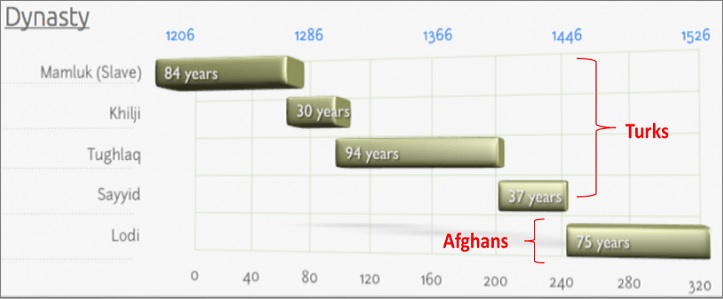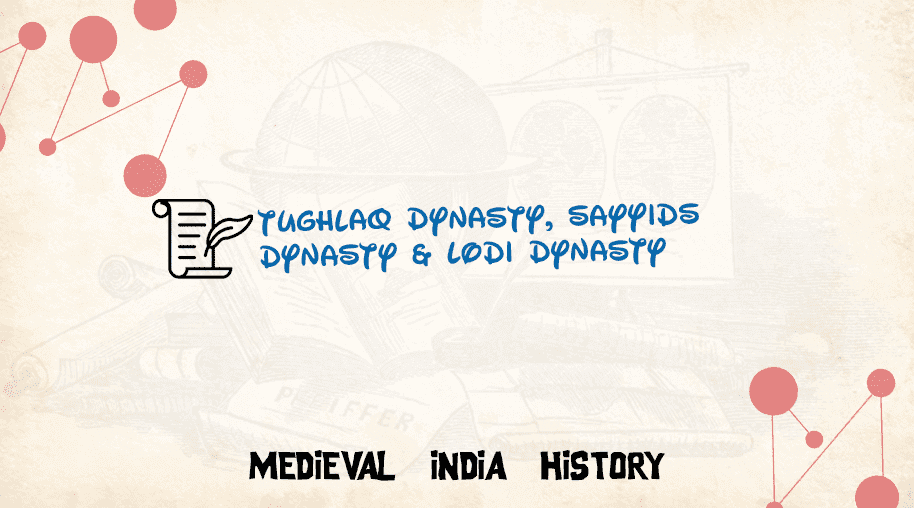Delhi Sultanate administration, art & Culture
by Devender
0 2045
The Delhi sultanate started with the Slave dynasty in 1206 and ended with the death of Ibrahim Lodi in 1526. During these 320 years, there were 5 different dynasties that ruled India. In this blog, we will discuss the administration and Art & Culture of the whole Delhi Sultanate.

Administration
The Sultans of the Delhi sultanate considered themselves as the representatives of Caliphs. Iltutmish, Muhammad bin tughlaq & Firoz tughlaq even received Mansur or a letter of permission from Caliphs for their rule.
All the sultans of the Delhi Sultanate were of Muslim origin. Balban from the Slave dynasty considered himself as the Shadow of God and of divine origin.
Sultans were the most important administrators and they were the chief of the commander of the army. The next greatest post after the sultan was Naib who enjoyed all the powers of the sultan and had general control over all departments.
- Diwan–i–wazirat: Head of the finance department
- Diwan–i–Ariz: It was the Military department headed by Ariz–i–Mumalik. It was responsible for recruiting & administering.
- Diwan–i–Rasalat: It was a department of religious affairs headed by chief Sadr
- Diwan–i–Insha: It was a department of correspondence that dealt with correspondence b/w rulers & officials
- Local Administration:
- Economy:
- Iqta land: Land assigned to officials as iqtas instead of payments for their services
- Khalisa land: These Land were under the direct control of the Sultan
- Inam land: The Land which was assigned/granted to religious leaders or religious institutions
- Social life:
The Head of the judicial department of chief Qazi & Muslim sharia law was followed in civil matters whereas Hindus were governed by their own personal laws & their cases were dispensed by village panchayats.

Provinces were known as Iqtas and were under the charge of Nobles to maintain law and collect revenue. Later, they came under the charge of governors known as Muqtis or Walis. Iqtas were further divided into Shiqs (districts) under Shiqdars. The shiqs were further divided into Pargana (no. of villages) headed by Amils. The headman of the village was known as Mukaddam or Chaudhary & the accountant was called Patwari.
The lands were divided into 3 parts:
Farmers used to pay one-third or even half of their produce as land revenue along with other taxes. They used to live hand-to-mouth living because of high taxes and frequent Famines. The cotton and silk industry along with the paper industry flourished during this period. 1 silver Tanka = 48 jitals in Khalji time = 50 jitals in tughlaq time.
The traditional caste system with Brahmans at the top was prevalent with Sati & parda system for women. Intermarriage between Turks, Iranian, Afghans & Indian Muslims was not allowed and Hindus were considered zimmis or protected people.
They had to pay a tax known as Jiziya. At the start, this tax was a part of land revenue but later, Firoz tughlaq separated it from land revenue & collected it as a separate tax.
Art and Architecture
Hindu and Jain's temples were destroyed and material obtained from them was used to build Quwwat ul islam mosque near Qutub Minar. Buildings were constructed by combining Arch, Minarets & Dome. The tomb of Ghiyasuddin tughlaq was built by Muhammad bin tughlaq on a high platform.
- Music:
- Literature:
Many new musical instruments such as Sarangi & Rabab were introduced in this period. During the reign of Firoz Tughlaq, the Indian classical work Rangdarpan was translated to Persian. Raja Man Singh (Gwalior) was a great music lover of this period. Pir Bhodan was among the famous Sufi Saints of this period.
Amir Khusro who lived from 1252 to 1325 introduced Ragas like ghora & Sanam and evolved Qawwali mixing Indian & Iranian music. He also invented the musical instruments called Sitar & Tabla.
Barani’s "Tariq–i–Firoz–Shahi" contains the history of the Tughlaq dynasty and Minhaj Us Siraj's "Tabaqat–i–Nasari" contains the general history of the Muslims dynasty up to 1260.
Amir Khusro was a very famous Persian Writer. He created a new style of Persian poetry called Sabaq–i–hind/Indian styled Persian poetry. He wrote Khazain–ul–Fatah about Alauddin conquests and wrote Tughlaq nama about the rise of Ghiyasuddin tughlaq.
Zia Nakshabi was the first one to convert Sanskrit stories into Persian. The first story that he converted was Tuti nama or book of parrot.
Kalhana wrote Rajat Rangini which was also translated into the Persian language during this period. Chand Bharati was a very famous Hindi poet of this era.

Share:







Comments
Waiting for your comments